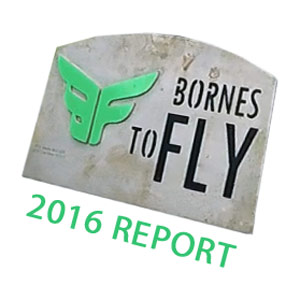
A tactical review from the midfield by Greg Hamerton: I don't like jogging. My normal day involves 10 hours or so of sitting at a PC, interrupted by exciting moments of coffee and chocolate. Occasionally, if the weather's good, I'll go flying instead. So to even consider something like the Bornes To Fly, I knew I needed some body-conditioning. Then there was the unavoidable fact that my name appears on the X-PYR entry list for July, along with Maurer, Durogati and Coconea.
So for the past few months I've been up at dawn with a bag on my back, striding out some miles in the hope some muscles would attach themselves to my legs while I wasn't looking.
.jpg)
I'm glad I did some training. By jogging I could just hold onto my position. On the flat. Photo © Karine Dupureur
Of course, the Bornes To Fly begins with an 800m ascent from the lake to the Montmin launch. Some athletes display leg power here, but I'm not far behind, running on enthusiasm. Everyone is so fired up, they're going like the blazes. It's an 8km hard hike and although I miss a 300m shortcut which most locals take, I lose little time on the smooth road. The rain has stopped but the clouds are hanging low. The leaders race off the back slope like a pack of greyhounds, but most opt for the official launch site. Maurer launches as I reach the mat, so I've lost only 5 minutes on him and 10 minutes on the leaders.
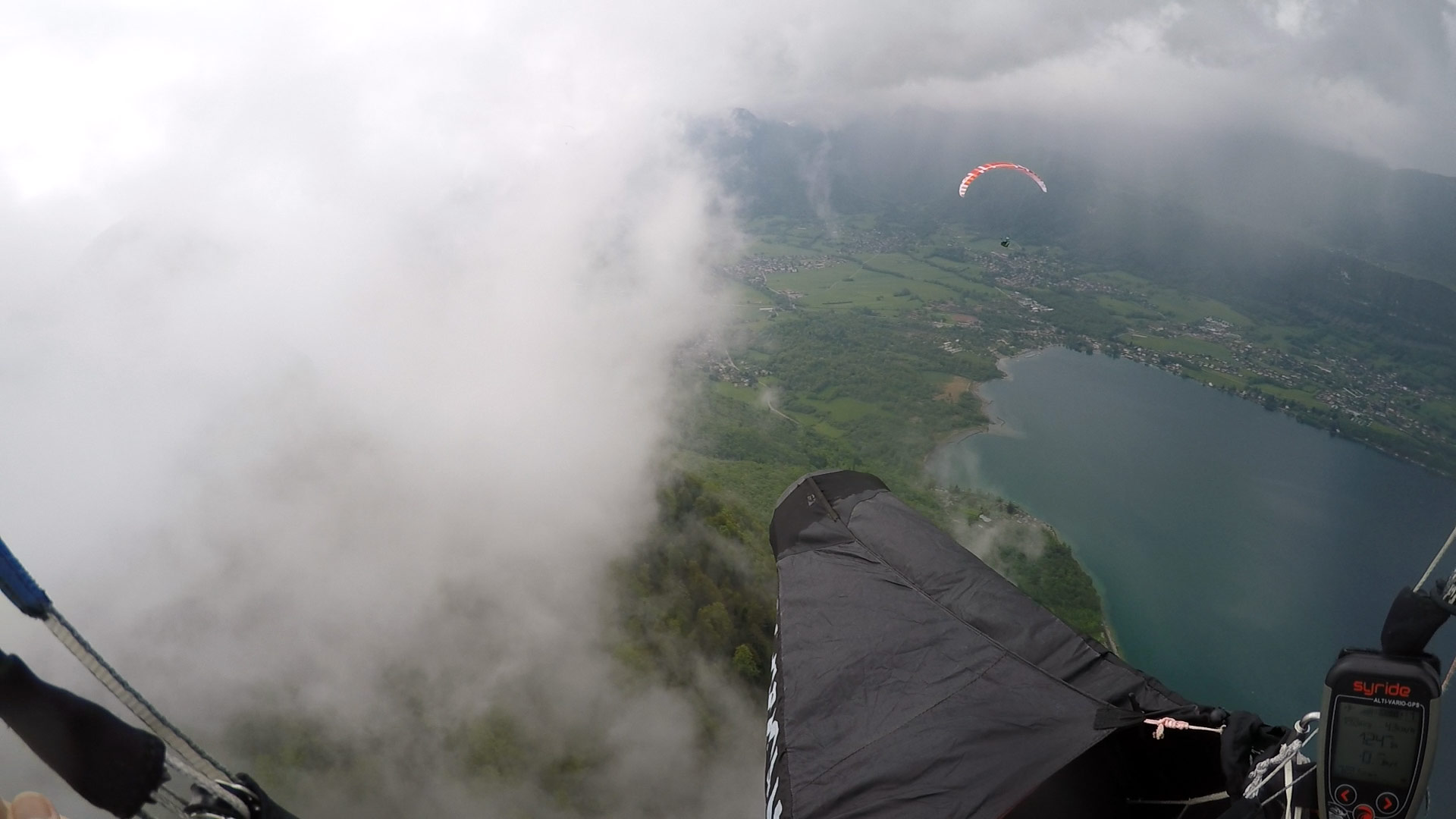
Setting off with Flybubble Team mate Alistair Andrews
A 9.5km glide follows. I'm near the front group, and manage to pick up a weak thermal to get to cloudbase. I'm in no hurry: I know how much faster it is to fly, so the game is to stay airborne. At a stretch, I might be able to cross the valley to the south ridge (facing into wind), but I follow the gaggle into a useless leeside with a sinky landing. Although I'm usually an independent thinker, it's obvious that there's a huge pull during this kind of race to follow the rushing herd. Koren comes in slowly, later, and gets a weak climb where nobody else does, taking him onto the south ridge which he works brilliantly to 1700m to get a glide to half way up the next mountain: the only pilot to bypass everyone in their valley slog and ascent.
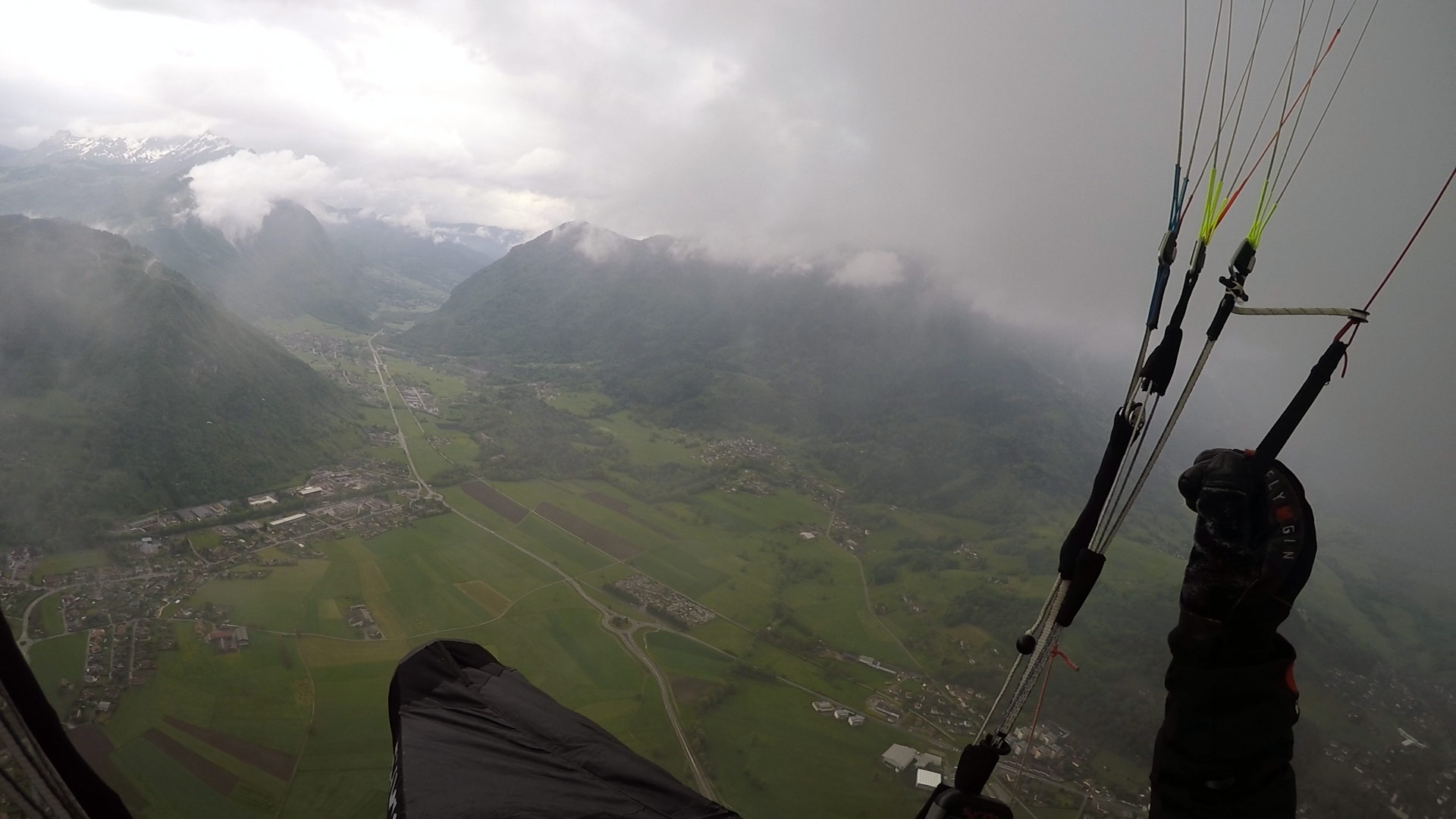
Missed opportunity - the wind is coming from the left, so we all got flushed on the left ridge. The right ridge is reachable.
For me, there's a 6km jog, followed by an 11km hike with 862m ascent. Maurer and Gallati reveal their leg power here, ascending 30 minutes faster than me (2 hours) and demolishing Koren's temporary advantage. Koren launches just as Maurer reaches the top, leading the lemmings in a still-air glide down the shaded valley. My Flybubble team mate Alistair Andrews goes for the all-out backwind launch, I decide to give myself better options in case the backwind strengthens by walking to a nearby crest. When I get there, I discover others used it too after passing me with a short glide and relaunch. I've lost another 10 minutes. The fastest option was to glide straight down to the valley and not waste any time.
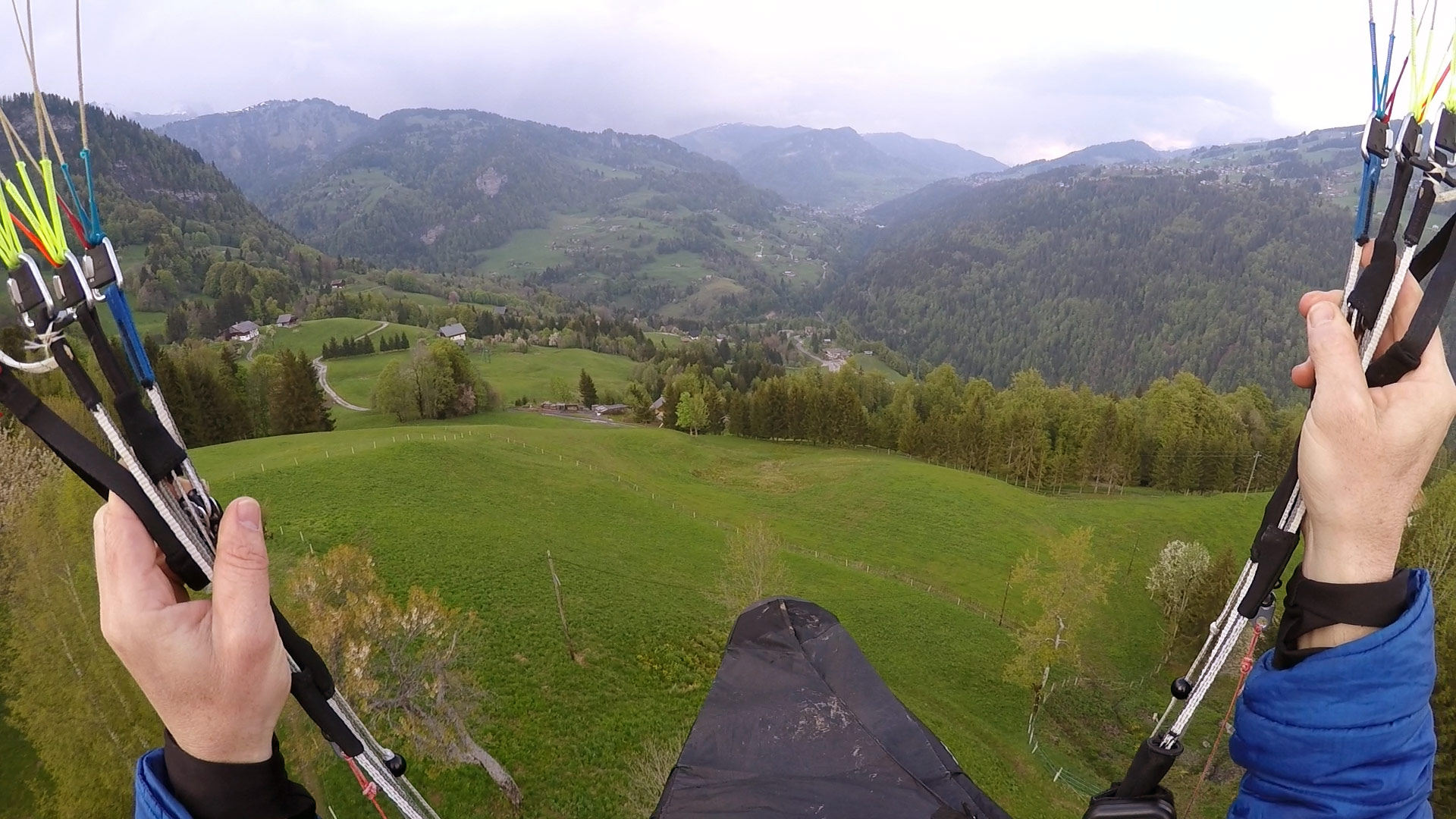
Sneaking through the trees to get a final glide for the day
A 4km glide over a tree-choked ravine follows, to the first few landing patches in sight. My wing gets sodden in the grass. It's 18h00 and we're at the bottom of a ravine, so it's going to be a march till cut-off time at 20h30. Some pilots take a high road to relaunch but it takes more time to ascend and pack than it is worth.
At 20h00 it starts raining. I have a surreal moment, wondering what I am doing, walking with a pack in the rain with a perfectly nice car following me, I mean, what kind of sport is this anyway? But I grin at my supporter James and press on. It's bonkers but I'm enjoying it. Gallati and Maurer pull ahead, jogging on the flat till closing time, widening the gap a little. I trudge on uphill, not able to go any faster.
I pass a bar. It doesn't go unnoticed.
There's a tactical decision to make at Flumet: either left to hike up the Aravis range for a late morning flight to Plaine Joux tomorrow, or right on a straight road to an early morning glide down to Passy, where a long ascent on foot surely awaits. I choose the certainty of covering distance. Who knows how late the Aravis will start working, after this rain? The south-facing training site at Plaine Joux is pretty much guaranteed, and the timing will be good.
Stop! It's 20h30, it's raining, and we're in a small pull-off space on a narrow road. There's a ticking sound as my engine cools. I check my levels: I think I need some beer.
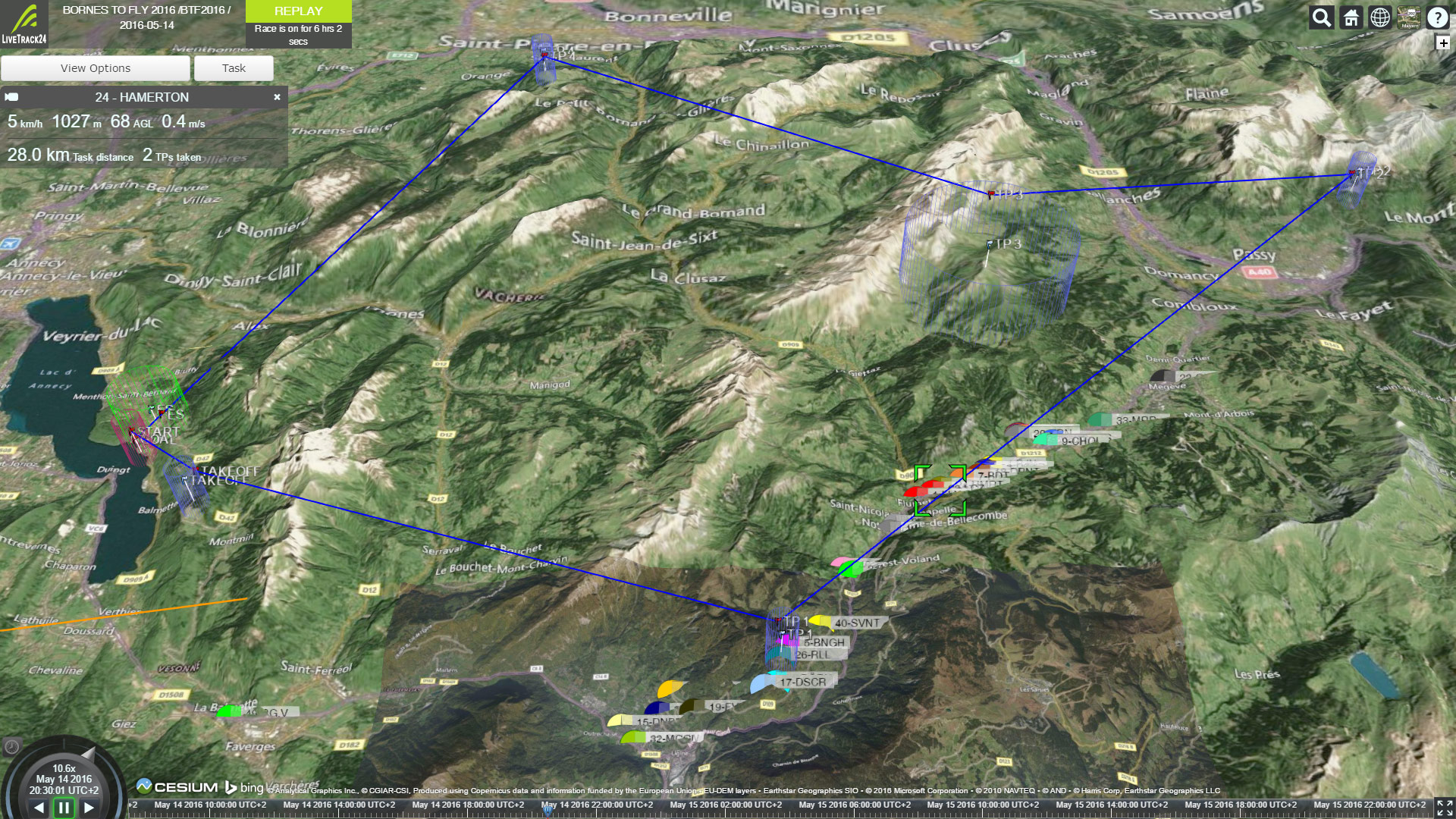
I'm in the green square, midfield, just past the junction where a few pilots aim for the Aravis (left) and most go straight
As James and I sample Flumet's finest, we review my performance. I'm doing OK in the ground race, and my legs are in good condition after 27km. But the pace is relentless, and fast. The leader (Gallati) is over 8km ahead. There are more than 10 pilots ahead of me and 5 close behind. Tomorrow will begin with more road racing.
Somewhat refreshed, we look for a campsite. Google maps usually works. Until it doesn't. It's May (too early in the year), and everything is shut. We drive from one closed campsite to the next, farther away from my starting point, deeper into the looming lack of sleep. Eventually we give up and pitch our bivi tents in one of the closed campsites, which means cooking in the rain, washing with a cloth, and getting to bed very late. No time to consider the maps and the route options.
Check out the race video of Day 1
Day Two: Full Commitment!

Camping in a closed campsite, in the rain. I take James on the best holidays!
The alarm goes far too early. It's cold outside so I stay a few more snug minutes in my sleeping bag. I'm missing some map tiles for my phone app, so I spend some time trying in vain to download them on the weak mobile data signal. I do my foot care, dress carefully, eat some oats. The campsite is too exposed for a morning loo stop. Striking camp takes time. All of a sudden ... damn, we're late! We hare back down the valley to get to my restart point, passing jogging athletes. I've just given everyone another 15 minutes. There's a 14km hike to do before the first launch.
Gallati loses his lead by hiking to the highest point but finding no launch site, and having to walk down through the forest. Maurer and Outters are off from a lower launch and the information spreads through the ranks. I am one of the many to benefit from the 'tested launchsite' and enjoy a quick glide to Passy. On the glide I try to research the best walking route on my phone.
Lebeau and Pinot take a bolder line, ascending the north ridge (towards turnpoint 3 at Croisse Baulet). They walk a long way into the mountains but don't find good flying conditions at 8am, just a glide. Their altitude allows them to cross to Passy but they have dropped about half an hour back through the field and they've burned some leg power. The same route has similar results for Lacaze, who launches at 10:30.
Alloix and Lafarie take a longer route to the same launch via the roads. They launch at 10:30 and stick to the mountain, working north on the turnpoint ridge before crossing the Sallanches valley. It only gives them 200m more altitude than Lacaze, but it's enough to allow them to find a climb and topland at Turnpoint 2, Plaine Joux. Their bold flying gamble might have paid off, but they have actually lost 30 minutes, and it's a further 30 minutes before they relaunch, presumably to allow conditions to improve.
In the meantime, everyone else has done a quick glide across the valley, walked 9km (750m ascent) up to Plaine Joux, and hopped off in gaps in the cloud. The crossing at Sallanches puts many pilots down, including Maurer (early, at 10h00). Those below the 1600m cloudbase have a hard time. Everyone who succeeds has to scratch up on the spine above Cordon.
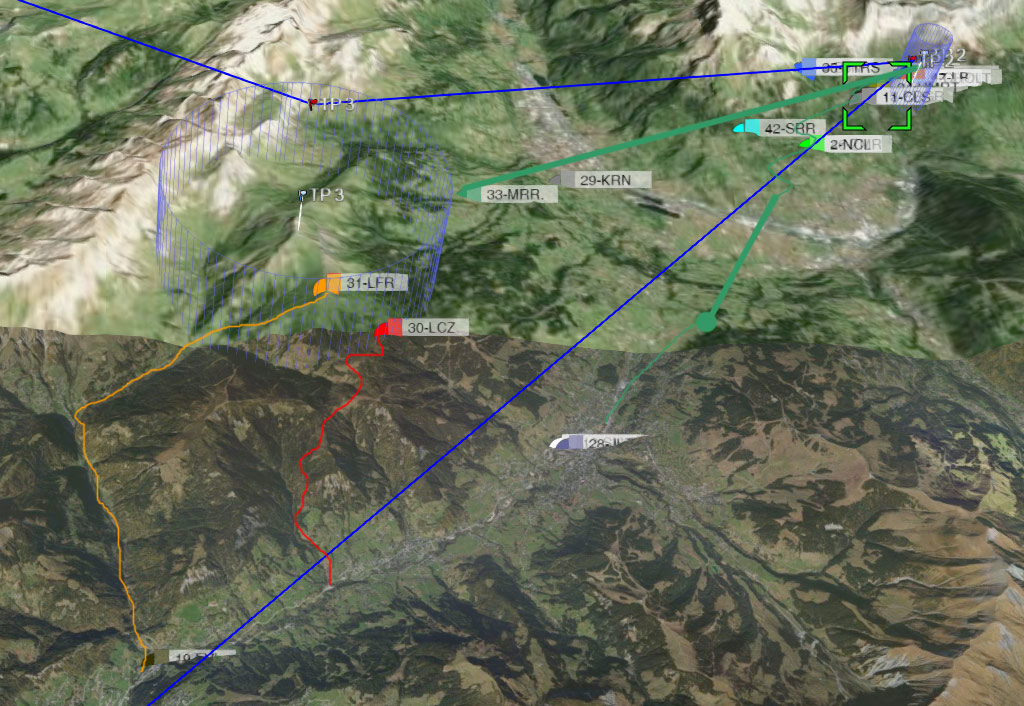
Rough morning routes: going into the peaks was slower than going straight. Maurer is leading, I am in the green square, in the midfield cluster around Plaine Joux.
The first gaggle to survive the crossing and (just) scrape up is there at 11h00. At the top they meet Maurer, who in that spare hour had packed, scaled 650m and relaunched. Maurer heads north and 5 pilots are hot on his heels, going upwind, as the building clouds capping the Aravis make the direct route impassible. From the tracklogs it looks like tricky flying.
Almost an hour later, Koren and Gallati relaunch and head north, the last to do so. Everyone else is too late: the drift takes us towards the col des Aravis, and the teeth of another valley wind system.
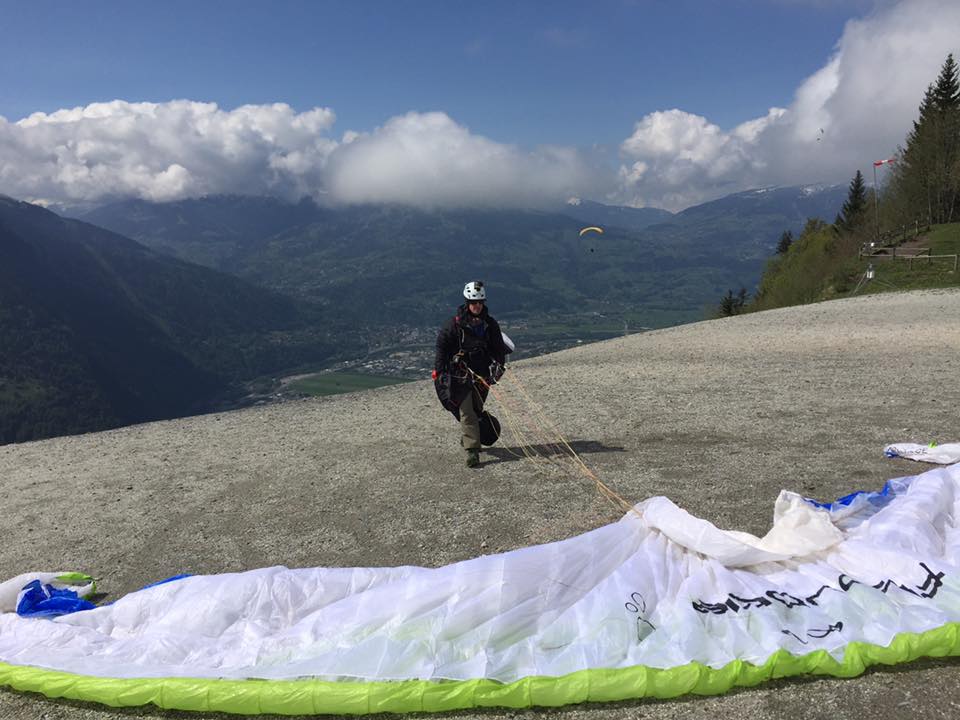
Setting up on Plaine Joux, after gliding down from somewhere in the middle distance.
By 12:30 the Sallanches valley wind is pumping and Andrews lands backwards in a graveyard. To add insult to injury he gets an earful from the mourners gathered at the graves.
Rounding the northern end of the Bornes range near Cluses, Chrigel shows his mastery once again, picking his way from peak to peak, always moving, sampling the air, even backtracking to soar around into the sunny lee side to see what was cooking before returning to the front face.
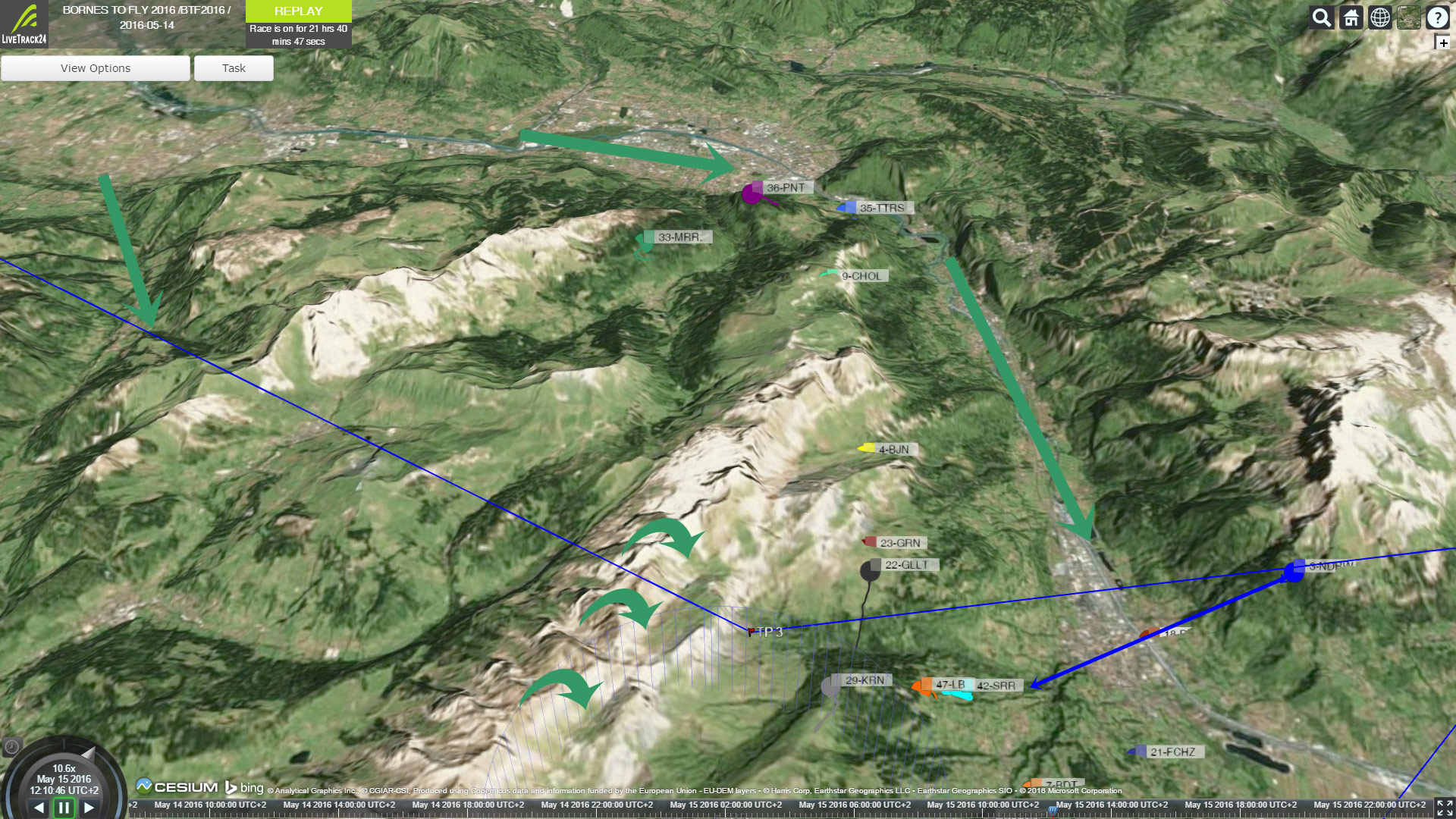
The valley winds and upper NW make the ridge lines hard to cross.
By 13:00 only Pinot remains airborne on his tail, at 13km behind, but he is soon grounded. All the other chase pilots have become stuck in the puzzle of peaks and tricky headwinds. By 13:34 Chrigel has swept through the goal cylinder, another victory comfortably in hand.
Pinot relaunches, bags the turnpoint, and blazes home at 15:00, followed by Outters, later by Chol and much later by Beaujouan, completing the first 'northern posse'. Garin has backtracked and joined the southern slackers, Gallati has straight-lined across the Bornes and Koren has been stopped by the valley wind.
Back in the midfield, after a 4km ascent (750m gain) I contemplate launching on the ski slope just within the 2800m turnpoint cylinder. It looks just steep enough to glide off. If it was sunny, I would go for it, but with nil wind and growing shade, I am not confident. The awful prospect of gliding down to the very bottom of the slope and having to walk up it again makes me decide to go higher. A tip from my supporter alerts me to the fact that Perger and Claus were off to the north of me, so I look for their trail, not marked on Viewranger.
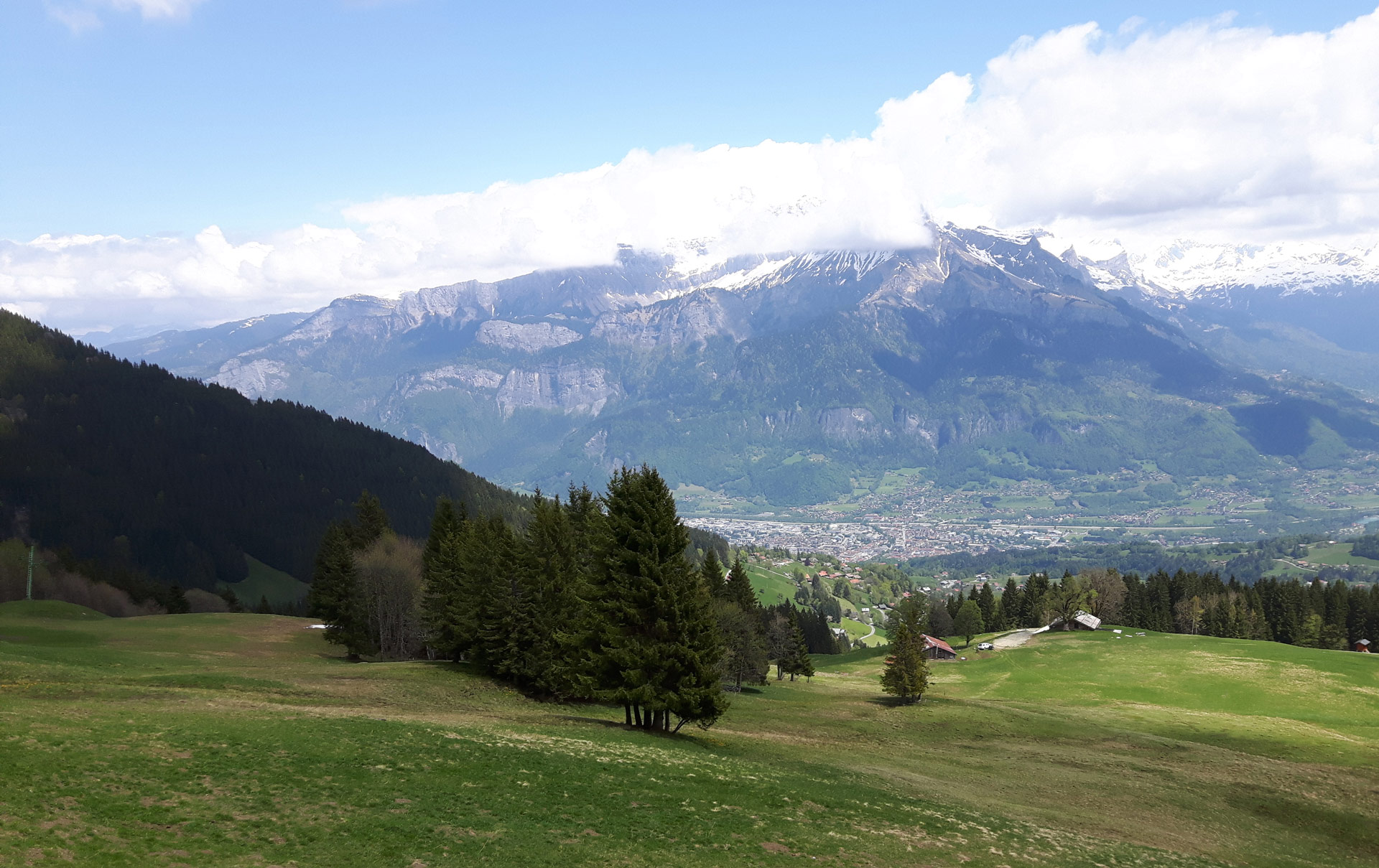
I should have flown from here. But while I consider it the shade grows (the sun is moving west). It's also downwind of the spine everyone has used to climb on, to my left, which will feed cool sinking air my way and be a real challenge to cross.
I lose almost 2 hours to this decision, this fork in the path. My trail gets steeper and steeper, leads into the snow line, into broken bush and slippery dead grass, ice, and ... a dead end. I'm 30m from the cross on the crest of this stupid little knoll, and I'm unable to continue. The snow melt is making the dead grass treacherous, the slope has a real kick to it at the top. There's snow everywhere and it's too steep for me to lay out a wing, and there's no wind to help a launch. I agonise over my options, but in the end decide to slide downhill, passing myself from one small tree to another to avoid slipping away.
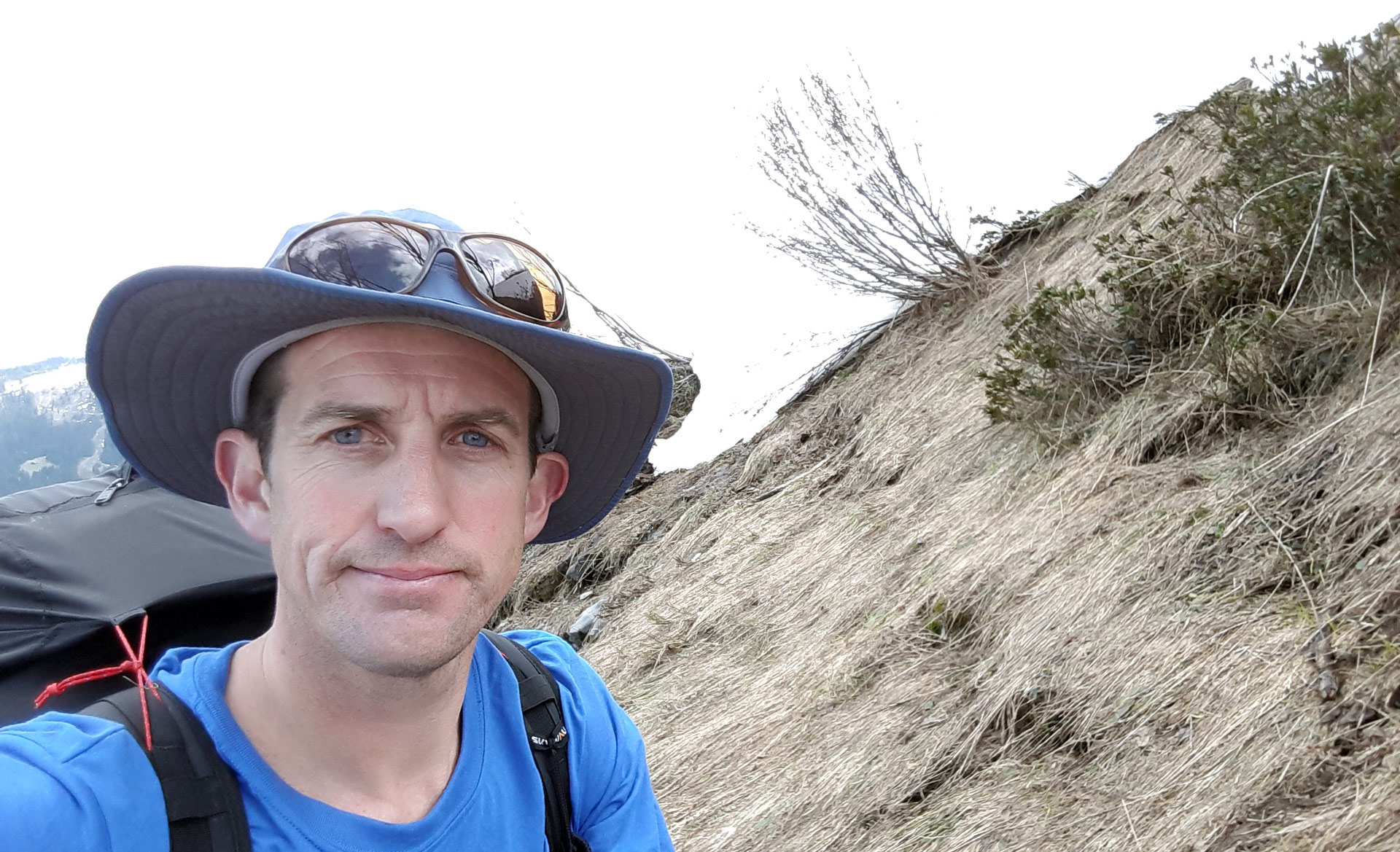
Bummer. Too slippery, too steep, melting snow, no grip. Have to go back down.
While I'm having my minor mountain moment, Lebeau and Serra topland on the snow above me and decide to hike OVER the Aravis, another 400m higher up a steep snowy section. This is a serious feat and it highlights the difference in mountaineering skill. Later Serra tells me "We had no crampons and no ice axes, just shorts and baseball caps. It was very hard. Lots of snow, one metre in places. The wind at the top was strong but good orientation. It was OK." They launch from the top of the Aravis and glide a long way towards the turnpoint before getting flushed at Entremont and having to fall back. Serra finds a climb, goes higher, and tries again, but still hits the horrible sink and only manages a few km further along the valley past Entremont. This puts him within hiking distance of the final turnpoint. Lebeau lands earlier and puts in a monster hiking effort to sneak in an evening flight from Sur Cou.
Luckily I'm unaware of the prowess of my fellow competitors - I've had no time to watch live tracking. I must work with the skills I have, on my piece of the course. I can fly.
I remember a rockfall I'd seen on the way up, and use it to set up. The wing rolls downhill on itself, the lines hook on sharp rocks, and time ticks away, until finally a thermal comes through and I can fluff the wing open, and up, and I'm away! I scratch for all I'm worth, climb out, and catch up to Claus, who has launched from the west side of the turnpoint, on the snow. Whew, disaster averted.
We wind up to the clouds, and it gets suddenly spectacular. We're in the lee of the Aravis chain, there's cloud pouring over the jagged snowy peaks. It's a full HD moment, but unfortunately my GoPro battery has died, victim to the hurried start and lack of checklists.

My last shot of the Aravis, on approach to landing in the foothills.
There's no way straight over the Aravis in the air, so we must crab sideways to the Col des Aravis, a big-time venturi. Topping out near cloudbase I stuff the bar and brave the glide. Claus holds back and watches me discover that the left wall has nothing but turbulent crosswind on it, and that I have no height remaining to dive over the right wall. Claus sails over my head and nips over the mountain with inches to spare.
I kite the wing up the grassy slope tucked in the hook of the col, and soar up in the sloppy turbulence. When I've done the best I can, I push ahead and try to follow Claus, but I need another 100m to get over the spine. I get drilled.
With the strength of the headwind, I can't see how it would be possible to get closer to the turnpoint in the air. I pack it in and become a boring snail on the livetracking, jogging downhill along the road. Mercifully, it's an easy decline with nice afternoon shade and a cool river breeze, and there's no stress as I don't have to fight in the air any more. Looking at the livetracking after the event, it seems I made the right call on not wasting time with a relaunch above La Clusaz, as all the other pilots who try it get nowhere.
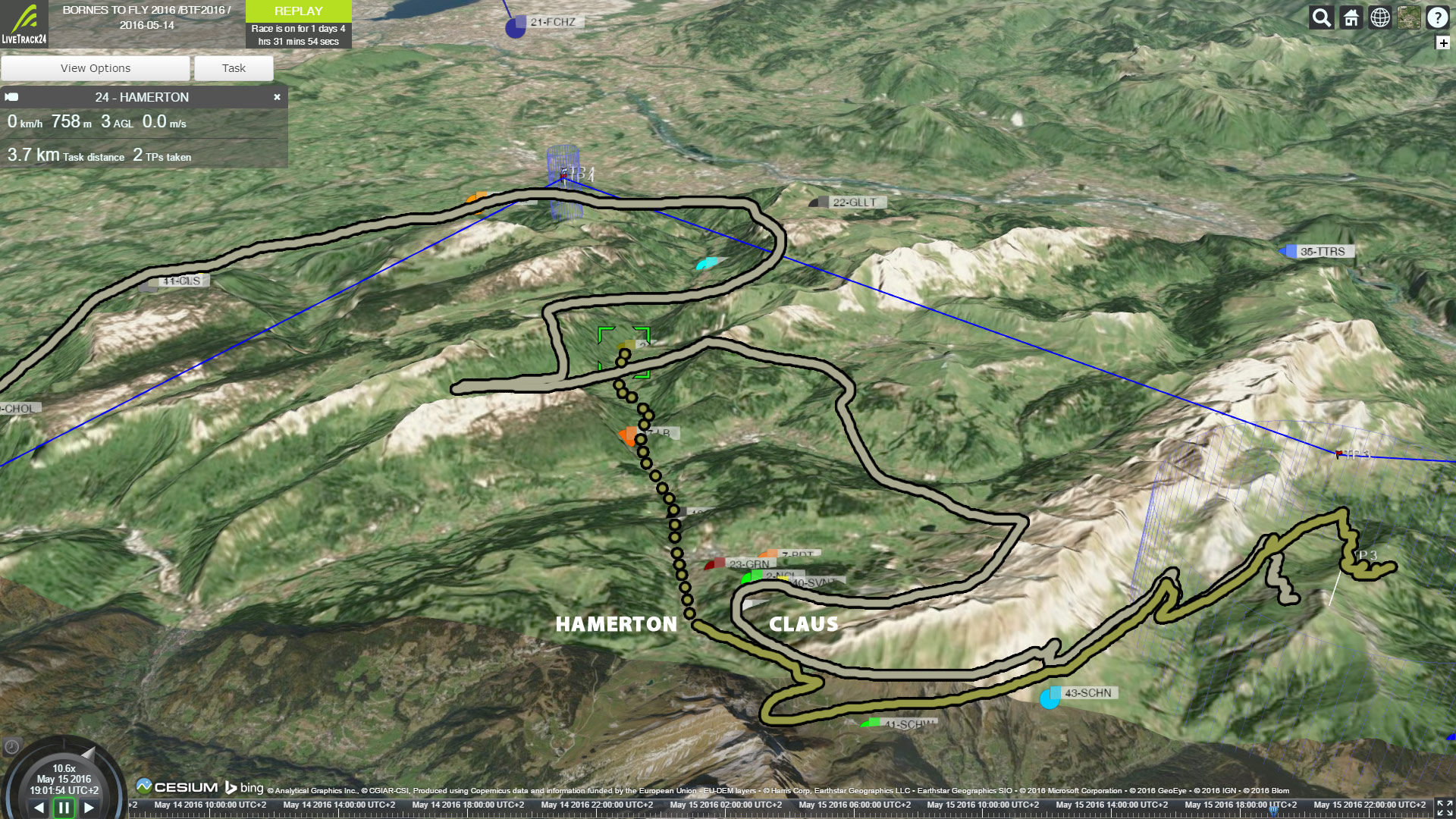
Clever tactical flying by Claus sees him reaching goal despite the headwind
But Claus soars like a cunning crow, back up the Aravis on the windward side, and begins to weave his way into wind. His track is worth looking at for an education in clever redirection and gritty determination, and it's my favourite flight of the event. Across the valley to the west of La Clusaz, Alloix and Lafare climb out from the peak they hiked up. Staying well clear of the main valley wind system and aiming over the highest ground they reach the turnpoint, then blaze home to Talloires.
On the ground, an 18km hike ensues, spiced up occasionally with some downhill jogging, although I'm wary of damaging my feet. My body definitely doesn't want to run, but I can't bear the thought of being passed by the horde at my back... I'm starting to feel the strain of being on the go since 6am. This would have been a good time to eat a meal, in retrospect.
I meet up with Perger and Koren and we swap stories. Koren has been frustrated by the headwinds. He's had a tough time on the north route, relaunching above Cluses, but unable to get established after a jump northwest he fell back and diverted southwest to the Route des Aravis valley where he fell prey to the heavy sink at Entremont. Beaufontain who launched after him from the same launch made it through and is now in goal. Those who fly well avoid a lot of effort on the ground.
By the end of the day the soles of my feet become hot, and it feels as if blisters are imminent. Thankfully the descent stops, and we go back to slogging up switchbacks, until James toots his horn and I can dump my bag in the car and switch off the livetracking.
My total for the day is 45km on the ground with roughly 1800m of ascent. Hooray, my first marathon, with a paraglider on my back. I only flew 27km, but it was glorious. That was a long day; the X-Pyr is going to be brutal.
Having learnt from our campsite debacle, James has booked us an Airbnb chalet for the night. Our welcoming French hostess is determined to have an animated conversation, despite our complete lack of French. The Navy boys (Andrews and supporter Starsmore) shack up with us, but we are the dullest party house in town. Eat, shower, straight to bed.
As I drifted off to sleep, something like this was playing through my mind...
Day Three: Get To Goal!
Up at 4:45, to ensure breakfast and ablutions are done. Despite the early start, I lose 5 minutes on the 06:00 gun, due to the long drive back to my start point. There's no spare time during the race! A campervan is definitely an advantage, as you can sleep much closer to your start point.

A wonderful dawn hike with James to Col de Sur Cou, then an attempt at crossing the back ridge
The day begins cold and clear, with a 7km hike up to the turnpoint at Sur Cou. There are two possible routes: glide off the northwest (shaded) side and walk up Le Parmelan for a relaunch, or hike southeast to the sunny side of the larger mountain chain that seems to lead more directly towards Annecy. It's deceptively attractive on the map.
As I near the turnpoint cylinder, Koren strides confidently past, going the other way. He's heading for the sunny slopes, over a steep col. It's all the confirmation I need: the higher route makes sense.
Serra (the Aravis summitter) spent the previous night in a refuge at Col de Sur Cou (without his assistant, because there was no road access that high). He shared the refuge with two families but there was lots of food and water. After hiking to the turnpoint, he also chooses the inland route.
Unfortunately this was a bad choice. Serra and Koren walk for 4 hours trying to find a launch between the Col and the Plateau des Glieres. There's a north wind, there's snow, the terrain doesn't drop off enough, and launch sites are limited.
Luckily for me, I'm held up. The path I follow leads through a steep, slippery forest then climbs up a steeper slope with loose footing. Then some icy snow where I am grateful for the bootprints I can balance in. There's a lot of exposure to my right, a long slope tilted at an angle that says 'slip and you won't stop'. The peaks rise vertically to my left. Occasionally, loose rocks skitter past me, of their own volition. My sweat feels suddenly very cold on my neck. I lean into the slope and walk with my hands and feet, trying to ignore the yawning chasm to my right. More loose gravel on hard rock, more thin sheets of melting snow. The slope tilts ever more. Then the trail fades away altogether.
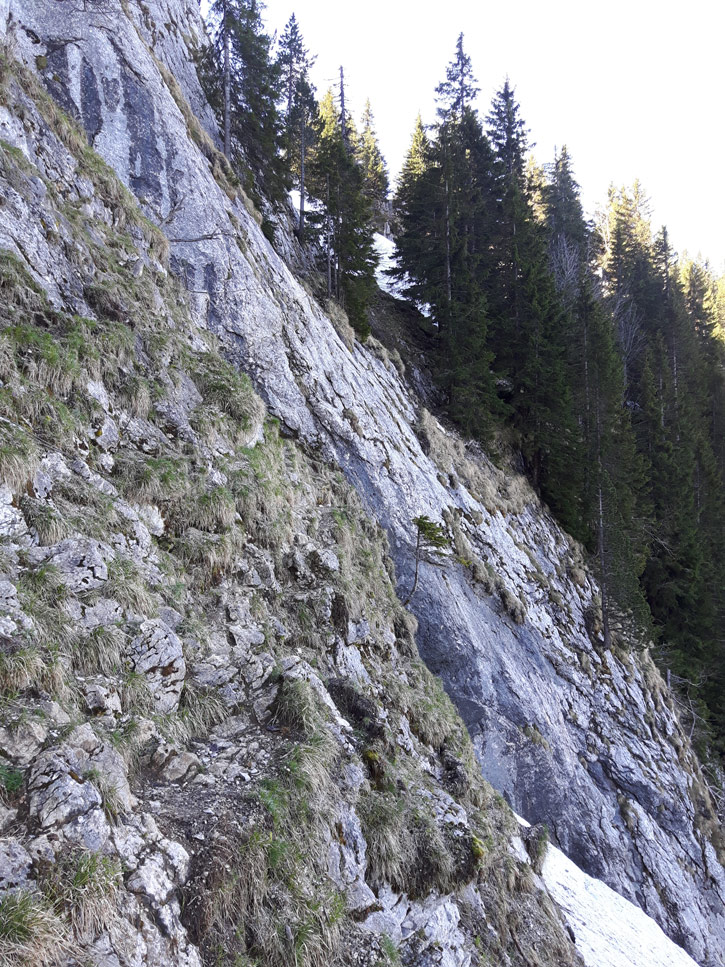
After a minute of ignoring the small squeaky voice in my head, I see it: someone has bolted a cable to the slope. Good grief. I take a deep breath and trust the engineering, but my grip isn't very good on the icy hawser, and the vertigo gnaws at my nerves. Then the cable ends.
You've got to be kidding me. There are a few cold spikes poking into a blank rock face like nails in a coffin, and way up above them, another cable. I reach up, but I can't trust my grip with my full body weight. I can't do it.
I consider my options. I don't care that the others have gone before; good luck to them. Once again, I must use the skills I have, not take chances with skills I lack. This is just too risky. One slip here and I'll be off the slope, tumbling past the cheeky chamois that have stopped to watch the spectacle.
I turn back for the turnpoint, and make my way down, one scary step at time. The exposure reduces in agonising increments, until I've completed the 2km detour and finish off the last of the 1000m morning's ascent to the grassy slope of Sur Cou, bathed in the gentle morning sunlight.
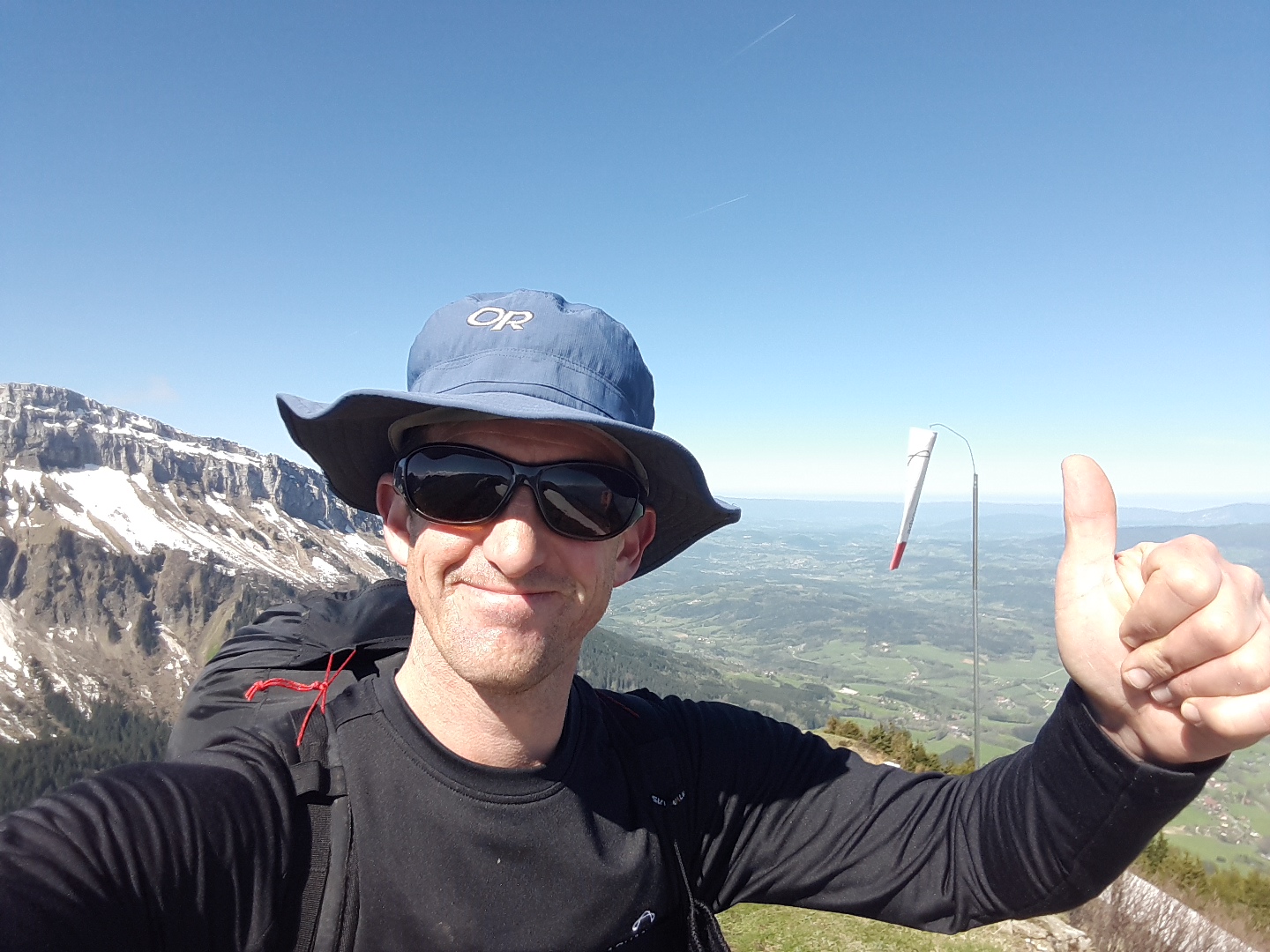
The official photographer sends his drone into the air, the windsock sways a little, and I'm off!
The easy launch is exhilarating. I am in my element again, away from treacherous rocks and snow and ice and stupid route decisions on winding trails. I can fly, straight to that slope in the sun, straight to the weak morning thermal, over to the next, and the next, above the snowline, over the peaks, gliding fast now with a glorious tailwind, past Fechoz and Garin who relaunch as I whizz by towards the goal line at Perroix. 22km of happiness. Not a single step walked!
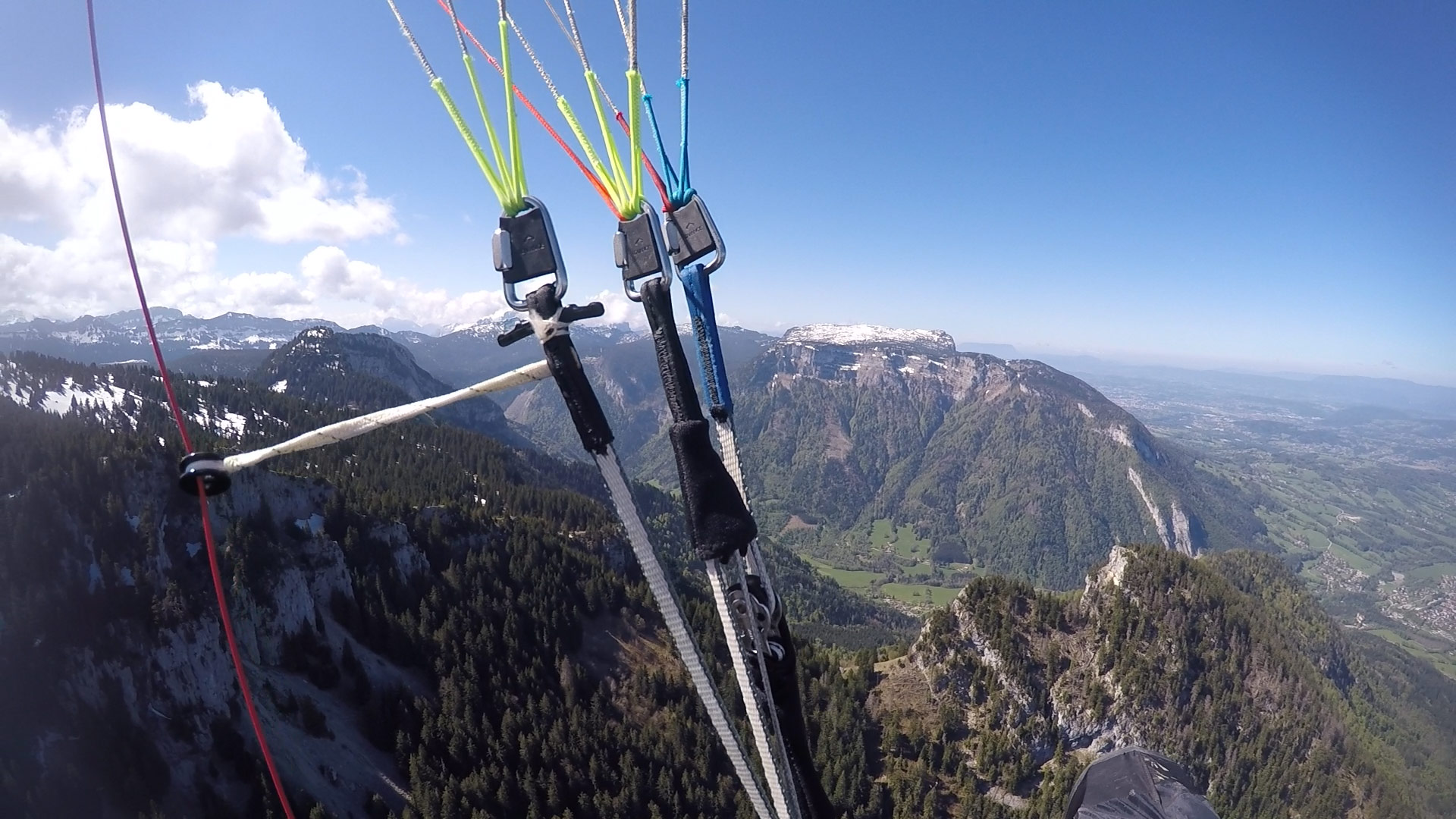
The two Frenchmen are more determined to race than I, and they dive into every leeside on the way to grab a minute on the goal line after getting a rowdy battering. I don't need the stress and I don't want to risk landing short so close to home. I see Serra coming in low after escaping the clutches of the hard inland route and I'm glad that he's made it. After 26 hours of racing, using every ounce of energy available in my legs, and every bit of flying skill I could muster, with all the variations in route choice and physical condition, it's surprising that four of us are racing to the finish line. I nip across the line and ease off the bar. I've completed the course and love the feeling of climbing and looking down on the goal field, the merry cluster of hobby pilots hanging over town and the special beauty of the Annecy flying arena.
Bornes to Fly? I think I am.
What an event, what a blast! 80km on foot, 62km in the air, 3 days of intense mountain fun and gruelling effort.
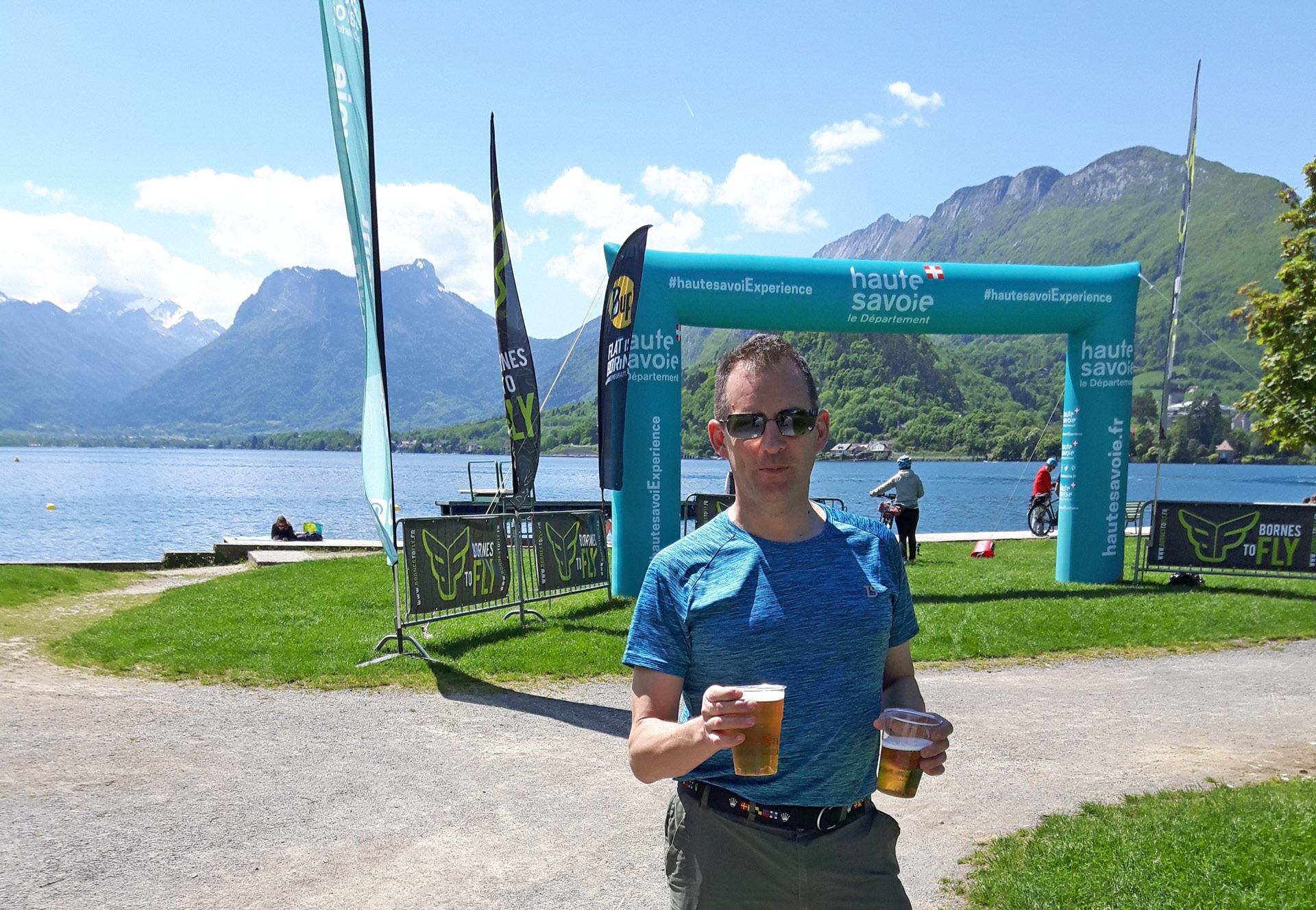
Is it a mirage? Race finish, Annecy lake, and my brilliant supporter James with a cold one. Cheers!
While I'm savouring my refreshments down by the lake, my team mate Andrews is pushing hard with a final run to reach the goal field before closing time. He'd put in a big hike to Sur Cou and a good flight in the strengthening northwind.

Hamerton in goal, Andrews on approach. Photos © Karine Dupureur.
Chatting to him afterwards he thought that lightweight race gear would have made the roadwork easier, but he was interested to see how little decisions on where to launch and how much risk to accept added up to big differences in the final day. Some of the more cautious pilots were a long way back. The most dramatic difference was made by flying, where Maurer transformed a serious challenge into a practice session of less than 24 hours. It's a brutal equation that he seems to have mastered: fly more, walk less. It's inspiring to see such skills on display and to learn from the many other lines scattered across the Bornes range that share a common goal: to move fast through the landscape, with an incredible aircraft.
Thanks to the organising team and helpers who made it such a great event. Most of all thanks to my James Hope-Lang, who was a tireless supporter and drove up endless switchbacks trying to find me, handed me welcome bottles of water and snacks, helped with navigation, found sneaky shortcuts, cooked up surprise meals, put up with late nights and early starts, and missed out on flying so I could chase a dream.
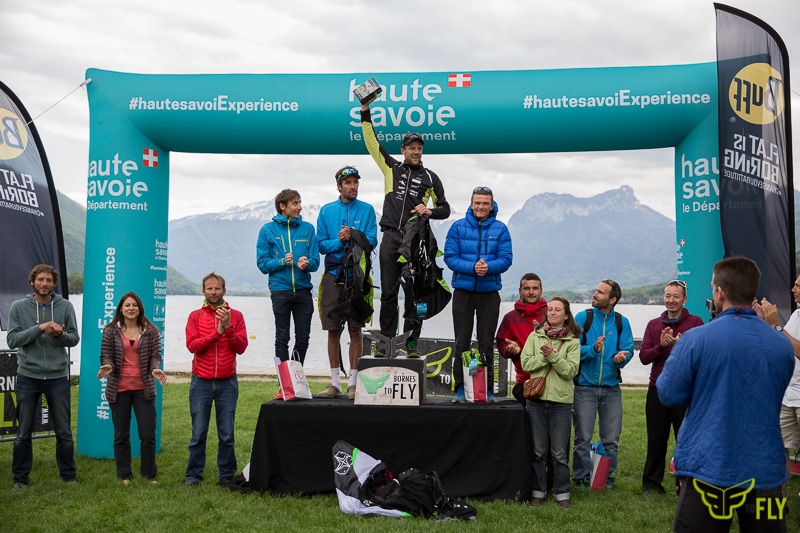
Chrigel Maurer (1), with Maxime Pinot (2) and Benoit Outters (3). Photo © Karine Dupureur.
Check out the video of the final day - I get to share my joyous experience thanks to my headcam footage and some slick drone shots by Antoine. What a stoke!
Visit the official Bornes To Fly website for more photos, results, and news. Come and participate next year!
Brought to you by Flybubble
Want to see more? There’s no better way to support our efforts than buying from us. We’ll ensure you get great service! Choose from our great range AND enable us to produce more videos and articles to benefit the freeflight community.

